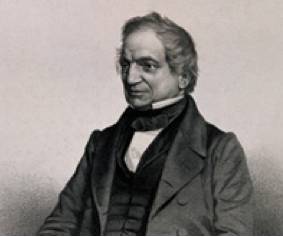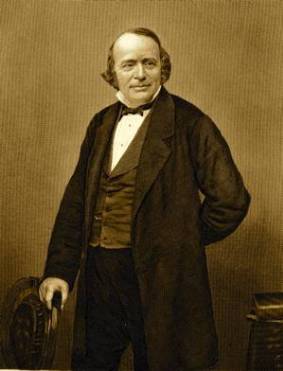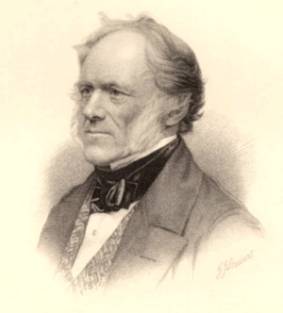On the Origins of New Forms of Life
6.3: Gradualism: Paleontologists' Objections
EUGENE M. MCCARTHY, PHD GENETICS
|
|
(Continued from the previous page)

|
|
Adam Sedgwick |

|
| Louis Agassiz |

|
| Charles Lyell |
Mayr (1982: 508) notes that after the publication of the Origin of Species, paleontologists objected to Darwin's claim that evolution is a gradual process and "insisted on the sudden origin of new types in the fossil record and on the total absence of intermediate types."¹ Adam Sedgwick and Louis Agassiz,² leading paleontologists, were among the most prominent of these opponents. These scientists claimed fossil evidence for gradualistic evolution was entirely lacking. Today these knowledgeable naysayers are often dismissed as religious fuddy-duddies. But even the agnostic³ Thomas Henry Huxley, Darwin's foremost advocate, saw inconsistencies in the geological record⁴ and warned Darwin that any absolute claim that new types always arise gradually would be an unnecessary burden to the theory.⁵
Remarkably, even Darwin's close friend, Sir Charles Lyell, the great proponent of gradualism in geology, eschewed it in the biological realm.⁶ In his influential Principles of Geology, Lyell used Cuvier's arguments to reject the notion of evolutionary gradualism.7 Lyell emphasized that the typical fossil form does not change with time.8 Much to Darwin's chagrin, his friend never accepted the idea of gradual natural selection.9,10 Although he had been open-minded enough to help Darwin get the Origin published, Lyell himself seems to have been a saltationist. He asserted the geological record shows each fossil form has a date of first appearance and a date of extinction¹¹ and that it typically changes very little during the interim.¹² He said these "births and deaths" are spread fairly evenly over time,¹³ so that the number of types surviving is smaller when the amount of elapsed time is greater.14,15 Some types, he said (and such is in fact the case), survive for long ages unchanged. Thus, he writes (Lyell 1835: vol. III, 395), that
This portrayal of evolution is fundamentally different from Darwin's, who emphasized the ongoing mutability of types, not their stability. According to Darwin, a hypothetical human population about to produce a new, nonhuman type would be initially homogeneous, but would, with time, break up into sub-populations. Due to a lack of interbreeding, these once-human sub-populations would become more and more distinct with the passing generations as they took on differing traits (perhaps long ears in one group and hairy skin in another). Each sub-population would then divide into sub-sub-populations, each of which would diverge in character from other sub-sub-populations, becoming less and less like humans with the slow passage of time (and less and less like each other). This process of division and divergence continues indefinitely. There is no sudden appearance of new types, as in Lyell's description. Instead, differences slowly accumulate along each separate line of descent. This is the basic account of evolution still given in modern neo-Darwinian theory (the notion of divergence long predates Darwin and can be traced back as far as the seventeenth century — discussion of this topic).
Darwin's ideas of intermediacy contrast starkly with those of Lyell. When Lyell spoke of intermediacy, he referred to the status of an assemblage of forms making up the flora and fauna as a whole (any given form within such an assemblage was, however, unchanging from "birth" to extinction). Thus, he would have said that the faunal assemblage that existed in North America 10 million years ago was generally intermediate between the assemblage that existed there 20 million years ago and the one that exists today. But Darwin used the word intermediate to refer to a link in a single, gradually evolving lineage. He said that a new form arises via a process where one form gradually changes until it becomes a new form.
Darwin's Gaps. The expectation under Darwin's assumption of strict gradualism is to see each fossil form slowly transforming into descendant forms in a more or less continuous evolutionary sequence. But 27 years after Cuvier's death, Darwin himself admitted the paleontologists of his day had still not found intermediates between fossil types. Thus, in the Origin he writes:
Darwin explained away this absence of "numerous, fine, intermediate varieties" by asserting that the geological record was "extremely imperfect." He claimed this imperfection (which was supposedly so extreme that gradual evolution would not be observed in the fossil record even if it had occurred) was the reason "why we do not find interminable varieties, connecting together all the extinct and existing forms of life by the finest graduating steps."17
This argument ran counter to the opinions of Adam Sedgwick."18 Sedgwick was one of the foremost geologists of the day. The namer of the Cambrian Period, he served as president and vice-president of the Geological Society of London. Just before Darwin embarked for his voyage aboard the Beagle, Sedgwick had given him a crash course on geology and the techniques of fossil collection. Although he remained on cordial terms with Darwin in later life, Sedgwick rejected the idea of the gradual origin of new forms through divergence and natural selection, and he rebuffed Darwin's assertion that the fossil record is excessively fragmentary.19 In a review (Sedgwick 1860) of the newly published Origin, he asserts that
The Missing Links are Still Missing. Nevertheless, Darwin continued to express faith that his "gaps" would eventually be filled by the work of future generations of paleontologists. Several of those future generations are now past, but the evidence gathered during the interim has only strengthened the view that the pattern seen by Cuvier is indeed typical, and that cases are rare in which one fossil type changes gradually into another. Milner (1993: 199) summarizes the glaring problem with Darwin's argument: "Another century of fossil discoveries, he believed, would fill in the picture. In fact, many transitional forms have since come to light, but they are still comparatively rare." More specifically, there seem to be very few examples of gradual evolution as Darwin described it. That is, of a single type gradually changing over evolutionary time until it becomes a new, morphologically distinct type. If there are any such cases, then they are at best very rare. Indeed, paleontologists Stephen Stanley and Derek Ager (1979) state that "the known fossil record fails to document a single example." Instead, Stanley (1981) says, there is a very marked tendency for each fossil form to appear abruptly, remain stable in form for long periods of time thereafter, and then to go extinct:
Moreover, major portions of the fossil record are now very well known and lack the gaps upon which Darwin's argument depends. For example, for any widespread marine organism, the fossil record is virtually continuous from the Cambrian, which ended almost 500 million years ago, to the present. The question then must be asked: Is it reasonable to base a general theory on what appears to be a rare phenomenon? Aristotle weighed in on this point. Thus, he writes (History of Animals, I, 6),
It is not enough to say, as did Ernst Mayr (1963: 436), one of the most eloquent proponents of gradualism, that "the 'missing links' between most of the major categories of vertebrates have been found in the 100 years since Darwin." These are not the "missing links" that pose a difficulty for neo-Darwinian theory. The problem is not to show there are distinct stable types, intermediate in form between other distinct stable types (such types would be expected to occur even if evolution were strictly saltational). The challenge, for anyone who claims that gradualistic evolution is the norm, is to document cases in which a single fossil form gradually changes into a distinct fossil form. Moreover, it would not be enough merely to show such transformations have occurred. It would in fact be necessary to show such transformations are typical of fossil forms. But it seems clearly documented cases are scarce at best.²² Certainly, then, there is no reason to suppose it is typical to observe one fossil type gradually changing into another. Moreover, given that gradual evolution is by definition a very slow process, we have no hope of observing it anywhere if not in the fossil record. Therefore, the idea that new forms typically arise gradually, in reproductive isolation, remains a belief without definitive empirical support. Whereas the origins of many forms produced by stabilization processes are now known evolutionary fact. NEXT PAGE >>
Notes:
(Works Cited)
1. Elsewhere Mayr (1982: 617) comments that all the great leaders of paleontology during the late nineteenth and early twentieth centuries — Cope, Marsh, Dollo, Abel, Osborn, and Matthew — all explained the origins of new forms in terms of saltation.
2. Swiss-born American zoologist, paleontologist, and glaciologist Louis Agassiz (1807-1873) studied under Cuvier and became the leading American naturalist in Darwin's day and the world's foremost authority on fossil fish. Agassiz and Lyell were longtime friends and each admired the geological work of the other (Gould 1979). As Winsor (1979: 111) points out “an idea of descent with modification, though far from Darwin’s, modeled on embryological development, was attractive to many of Agassiz’s contemporaries. He [Agassiz] could perfectly well imagine such a process of transformation, but he saw no evidence of it actually having taken place.” In his assessment of the evidence, new forms typically came into being abruptly, and then persisted without appreciable change, right up to the time of their extinction.
3. Huxley coined the term agnostic to describe himself.
4. Milner (1993: 393).
5. Huxley (1860; 1901: 189); Mayr (1982: 742).
6. Although, in his explanations of evolution, Darwin seems to have been a strict gradualist, Lyell described how sudden huge catastrophes could occur through ordinary agencies, for example, an earthquake causing the Mediterranean to suddenly inundate the Caspian basin. See Lyell (1835: vol. III, 130).
7. Gillispie (1996: 130).
8. Because Lyell offered no explanation of how new fossil forms could appear suddenly, some authors have suggested he was a creationist. Lyell's actual outlook, however, seems to have been more complex. He believed God was the “First Cause” of every event, but that God had laid down natural laws that were the “intermediate” or “secondary” causes of events here on earth. In his view, scientific explanation was a matter of seeking out these secondary causes or natural laws (see Lyell 1835: Vol. II, 426). Lyell’s true attitude can be judged from his response to comments on the topic made by his friend astronomer Sir John Herschel. In a letter Herschel asserted that the process producing new organisms, “could it ever come under our cognizance, would be found to be a natural in contradistinction to a miraculous process—although we perceive no indications of any process actually in progress which is likely to issue in such a result” (Wilson 1972: 439). In response, Lyell said he had left this point “to be inferred” in his book because he didn’t think “it worthwhile to offend a certain class of persons by embodying in words what would only be speculation” (ibid: 439). Thus, it seems clear that Lyell believed new types of organisms actually are created by natural means, but that he didn’t know what those means might be and didn’t wish to offend anyone by speculating. Being circumspect is hardly the same as being a creationist.
9. Lyell (1881: 442-443).
10. Even in his book, The Antiquity of Man (1863), in which he attempted to accommodate Darwin, Lyell refused to exceed the simple admission that the human race is “old” and nowhere said a fossil type gradually changes with time (Desmond and Moore 1991: 515).
11. Lyell (1835: vol. III, 372-377).
12. Lyell (1835: vol. II, 418, vol. III, 393-396).
13. Lyell (1835: vol. III, 373).
14. Lyell (1835: vol. III, 395).
15. Lyell knew the proportion of extinct to extant forms in a given stratum progressively rises with a stratum’s age and used this insight to establish the relative ages of geological formations located in different parts of the world (Lyell 1835: vol. III, 395).
16. Darwin (1859: 299).
17. Darwin (1859: 342).
18. According to Milner (1993), Adam Sedgwick (1785–1873) had an "essentially generous and placid nature" and was "much beloved by many generations of geology students." Modern writers have often condemned Sedgwick because he was, in his youth, a proponent of the claim that geological evidence demonstrated the past occurrence of the biblical flood. But such was the view of many, perhaps most geologists of his time. In 1831, after reading Lyell’s Principles of Geology, he publicly recanted his former position: “Having once been myself a believer and, to the best of my power a propagator of what I now regard as a philosophic heresy … I think it right, as one of my last acts before I quit this Chair [as president of the Geological Society], thus publicly to read my recantation. We ought, indeed, to have paused before we first adopted the diluvian theory, and referred all our old superficial gravel to the action of the Mosaic Flood. For of man, and the works of his hands, we have not yet found a single trace among the remnants of a former world entombed in these deposits” (see Sedgwick 1831).
19. Desmond and Moore (1991); Milner (1993); Sedgwick (1860).
20. Darwin sent a copy of the Origin to Sedgwick on its publication. In a letter dated 24 Nov. 1859 (see and Smith 1991), Sedgwick gave Darwin his assessment: "If I did not think you a good tempered & truth loving man I should not tell you that (spite of the great knowledge; store of facts; capital views of the correlations of the various parts of organic nature; admirable hints about the diffusions, thro' wide regions, of nearly related organic beings; &c &c) I have read your book with more pain than pleasure. Parts of it I admired greatly; parts I laughed at till my sides were almost sore; other parts I read with absolute sorrow; because I think them utterly false & grievously mischievous — You have deserted — after a start in that tram-road of all solid physical truth — the true method of induction — & started up a machinery as wild I think as Bishop Wilkin's locomotive that was to sail with us to the Moon. Many of your wide conclusions are based upon assumptions which can neither be proved nor disproved. Why then express them in the language & arrangements of philosophical induction?"
21. Translated in Osborn (1894: 47–48).
22. Kucera and Malmgren (1998) say even those few studies purporting to demonstrate phyletic gradualism often suffer from a serious logical flaw. When a new form arises suddenly and the form it arose from then gradually dies out, they say (ibid: 60) sample means for the morphological characters distinguishing the new form will seem to show a gradual shift over time. However, as they point out, this is a mere artifact caused by calculating means using samples that include both the new type and a declining old type. For example, in their own study those authors evaluated two foraminiferans, the conical Contusotrucana contusa, and its flat ancestor C. fornicata. What at first seemed to be a gradual increase in conicity from C. fornicata to C. contusa, turned out to be a gradual increase of the mean value for "conicity" subsequent to the abrupt appearance of the fully conical C. fornicata. The mean shifted gradually because the flat C. fornicata specimens gradually declined in number over time as they died out (not because the conic C. contusa form gradually arose by slow alterations from the flat C. fornicata type). Studies claiming to demonstrate phyletic gradualism appearing to suffer from this sort of logical deficiency include Arnold (1983), Hunter et al. (1988), and Malmgren and Kennett (1981). To demonstrate phyletic gradualism one must show one fossil form gradually changes into another. To do this, one must first show (1) that each of a series of temporal samples is internally invariate with respect to the traits defining the form in question (that is, the possibility should be eliminated that the samples might contain individuals of two distinct stable types that are merely changing in relative frequency over time); and (2) that the members of the series gradually change over time so that they connect the ancestral and descendant forms.